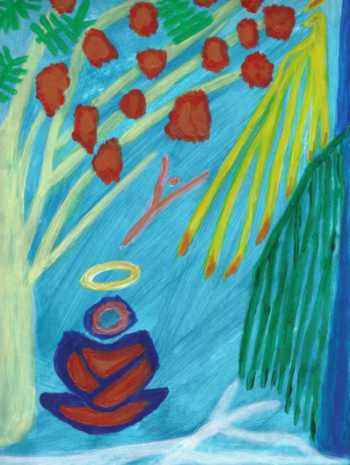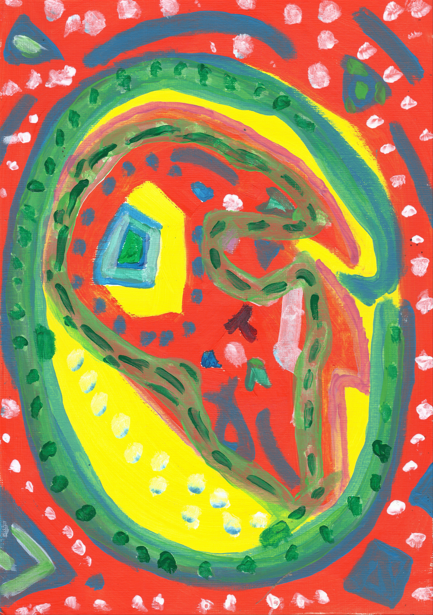The four noble truths
1. Knowledge of suffering. (Which is to be understood).
What does it feel like to suffer? To feel stressed? To feel dissastisfaction? To feel discontent? How does that feel? No need to give it a perfect label, sometimes it is hard to put it into words. Just say, suffering feels like this. Most of us know from our own direct experience of life what it is to suffer.
2. Knowledge of the cause of suffering. (Which is to be abandoned).
Knowing that whenever there is suffering, desire is also present in its three forms:
1. Wanting something. (greed)
2. Wanting something unpleasant to end. (aversion, pushing away)
3. The desire for becoming. (Our aspirations. The mind's tendency to identify with things, to take things personally. The story of self. The selfing. ' I want to become this, I want to become that. I don't want to become this. I don't want to become that. I am this, I am that. This is mine, I own this, I own that. I want this, I want that.' To counteract this tendency of the mind, it is good to recite often: 'Not me, not mine, not self'.
The desire for becoming can be used skillfully to realise the end of suffering. As desire is what drives us.
Desire comes from feelings, which are either pleasant or unpleasant. And feelings come from sense impressions: sight, sound, smell, taste, touch, and ideas/ thoughts.
We cling to what we want more of; and push away that which we don't want. We want the pleasant feelings to continue and experience suffering when we don't get what we want, and then feel aversion, bitterness, resentment, and take it personally. But everything is changing and uncertain, the world is outside our control. We cling to phantoms of moments. Chasing after the delights of the six senses like a dog chasing after its tail. Sense gratification is much like an itch, there is only gratification as long as one keeps scratching.
One cannot do much about sense impressions. They happen because we have a body. One also cannot do much about feelings (pleasant, neutral or unpleasant,) they arise because of sense-impressions. Desire may also be something we can't do much about, as it happens automatically because of feelings. But there may be a way to deal with it by slowly and gradually starving it of fuel till it goes out altogether.
One can expand awareness and make it like infinite space, so it shares the same quality. Space can contain many objects, but is not the objects it contains, and is not conditioned by them. One can make awareness like this, and then allow desire (in its three forms) to arise and cease at the sensory level of awareness, before it becomes a story. One can let it be there without judging it. But also not going along with it, not following it, not getting involved. Letting it arise and cease in an expansive space-like awareness without getting tangled up in it.This gets easier to do as one wises up and becomes less ignorant of where desire leads, becomes less ignorant of the link between desire and suffering, usually after bitter experience, where one remembers and decides not to follow it anymore.
3. Knowledge of the end of suffering. (Which is to be realised).
How does the mind feel when it isn't suffering?
Notice when the desire ceases and is no longer present, the relief this brings to the mind. To no longer have that nagging feeling of lack when one doesn't get what they want.
It feels good when the mind is free from greed, aversion, and delusion. It is helpful to spend some time noticing this.To appreciate it and pay special attention to how it feels when there is no anger, no irritation, no resentment, no taking things personally, no lust, no grasping, no chasing, or acquiring. How does that feel to be free of that?
There is a sense of freedom when one realises they no longer have to go along with their desires, their impulses, the urges. No longer have to be a slave to passion, pulled in different directions by the six senses. The relief of no longer being driven around by them. When the mind no longer feels harrassed by greed, hate and delusion, joy and serenity naturally rises. An unharrassed mind is a happy mind.
4. Knowledge of the path that leads to the end of suffering (Which is to be developed).
Knowing that the practise and development of the noble eightfold path is what trains the mind to become an instrument capable of understanding, seeing and realising the wisdom contained in the four noble truths.The noble eightfold path is the skillset needed to extinguish craving.
One can apply the four noble truths like a template to one's own direct experience of life as it is. One can practise it with the mild irritations, the mild forms of greed in daily life, and this works like a vaccine, like homeopathic medicine, through that experience we find that when the more unsettling things happen in life, the deep upsets, that we can manage those better because of practising with the lesser upsets.
We grow and awaken through the understanding of our own suffering, what causes it, how it ceases, and how the wisdom to do this develops. Then as one's suffering decreases, it can become easier to include others, to expand awareness to include the whole world, the whole galaxy if you like, to show boundless compassion to all beings. As one understands that others suffer the same way we do, that suffering is an experience shared across all the myriad species of life on this Earth. Empathy develops.
The four noble truths is an ingenious memory device, an easy to remember template for decreasing suffering in our lives. Like fractals, the four noble truths contain the noble eightfold path, and the noble eightfold path contains the four noble truths.
Most of us will have to keep reminding ourselves of this a thousand times a day for perhaps a thousand days or more. The length of time decreases as minfulness grows stronger. And it is normal to forget, to get caught up in the world again and tangled up in desire. Sometimes this forgetting happens for short periods of time, and sometimes for lengthy periods of time, and for some it can be as long as lifetimes. But then remembering happens again and one resumes the practise, puts in a more sincere effort than before, usually after a painful experience caused from being tangled up in desire. And each time one remembers and practises it weakens that link in the chain of dependent origination between craving and clinging. Keeps weakening it till eventually it breaks altogether and suffering comes to a complete stop and then there are no more states of becoming, no more states of woe.

